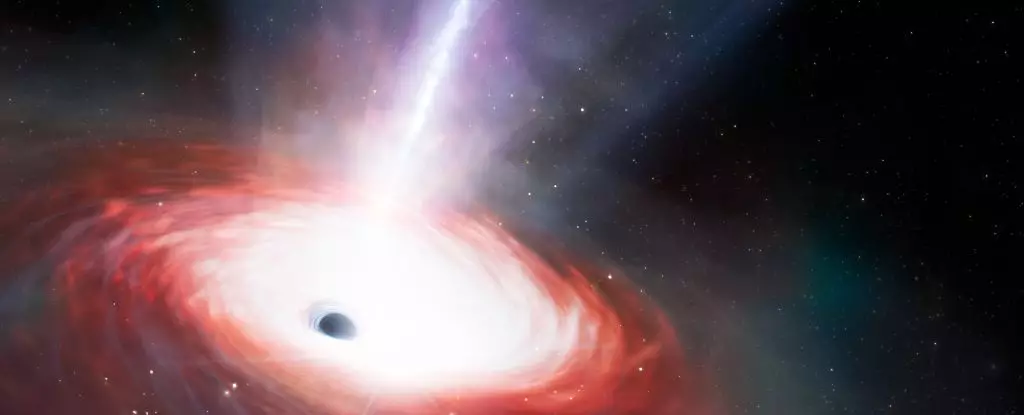

In a remarkable discovery, astronomers have identified a supermassive black hole located in the galaxy LID-568, existing just 1.5 billion years after the Big Bang. This black hole stands out as one of the most voracious specimens ever observed, drawing in material at an astonishing rate that surpasses the Eddington limit—an upper boundary for how rapidly a black hole can accrete mass without being countered by the pressure of emitted radiation. The extraordinary findings regarding LID-568 offer crucial insights into one of cosmology’s most pressing mysteries: the mechanisms behind the rapid growth of supermassive black holes in the nascent universe.
The Eddington limit serves as a fundamental principle in black hole physics, dictating the maximum rate at which mass can be drawn into a black hole before radiation pressure pushes back against the gravitational pull. In essence, when abundant material spirals into a black hole, it forms an accretion disk that intensifies due to immense gravitational forces and friction. While the light emitted from this disk could create outward pressure, the mass influx must create extreme luminosity to exceed the Eddington threshold. Typically, crossing this limit leads to a balance where the black hole is unable to accumulate more mass, presenting a significant puzzle when observing black holes that challenge these established norms.
The extraordinary accretion rates observed in LID-568 suggest the occurrence of super-Eddington accretion. During such episodes, a black hole rapidly ingests mass despite the fierce radiation pressure attempting to force material outward, effectively breaking past the theoretical constraints imposed by the Eddington limit. This phenomenon hints at the possibility that the first generation of supermassive black holes could achieve their formidable masses more rapidly than conventional theories suggest. Harvard astronomer Julia Scharwächter characterizes these findings as evidence of extreme feeding mechanisms at work, propelling theories that could redefine our understanding of cosmic evolution.
A team led by Hyewon Suh from the Gemini Observatory and the National Science Foundation’s NOIRLab employed the James Webb Space Telescope (JWST) to investigate the faint galaxy LID-568. Initial observations focused on a selection of galaxies that emitted X-rays but displayed dim characteristics across other wavelengths. Once they pinpointed LID-568, the challenges were substantial. The galaxy’s weak visibility led to further scrutiny, necessitating the precision of JWST’s NIRSpec instrument to clarify its position and intrinsic brightness, revealing its remarkable luminosity despite its distance.
The significance of LID-568 extends beyond its mere existence; the black hole within exhibits powerful outflows indicative of vigorous accretion processes. This finding alludes to material being expelled into space, a characteristic signature of an actively feeding supermassive black hole. As observed, LID-568’s mass was found to be approximately 7.2 million solar masses, relatively modest compared to some of the largest black holes in the universe. However, its ability to produce radiation at rates indicative of far greater mass challenges existing models of black hole accretion dynamics.
The implications of LID-568’s discovery extend into the broader realm of cosmological studies. This rare glimpse at super-Eddington processes offers researchers a potent avenue to explore how supermassive black holes formed shortly after the Big Bang. One popular theory contends that these enigmatic giants did not solely originate from standard stellar evolution, but rather from massive proto-stars and dense gas clusters collapsing directly under gravitational forces. The bursts of super-Eddington accretion might serve as further evidence supporting this framework, providing a fresh perspective on cosmic history.
Noteworthy is the fact that the detection of LID-568 comes amid advancements in observational astronomy, spearheaded by cutting-edge instruments like the JWST. As scientists continue to analyze this galaxy, the potential for uncovering the nuances of black hole formation and growth during the early universe is immense. This endeavor will undoubtedly ignite further discussions in the academic community, inviting new explorations into one of the most astonishing facets of cosmological science.
Unraveling the secrets of supermassive black holes is no small feat, but the examination of LID-568 offers a beacon of hope and opportunity. By challenging existing boundaries and understanding the mechanisms at play in the early universe, researchers stand at the precipice of a revolution in cosmic knowledge. As the mysteries of LID-568 unfold, they remind us of the ever-evolving landscape of astronomy where each discovery invites further inquiry into the marvels of our universe.
In the realm of software development, the ability to swiftly and accurately address bugs is…
The realm of quantum computing and communication is not just an abstract dream anymore; it…
In a remarkable leap for the field of material science, a collaborative research initiative has…
Throughout Earth's vast history, our planet has endured five major mass extinction events that reshaped…
Rainfall is a vital element of our planet’s hydrological cycle, yet many aspects of its…
On a night when the universe aligns, a mesmerizing phenomenon awaits: the appearance of the…
This website uses cookies.